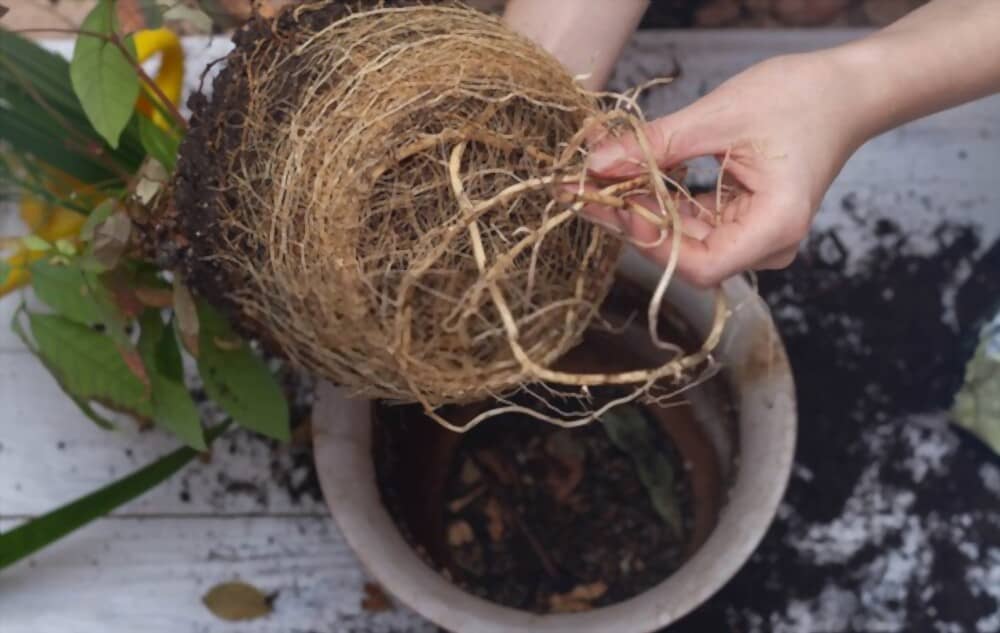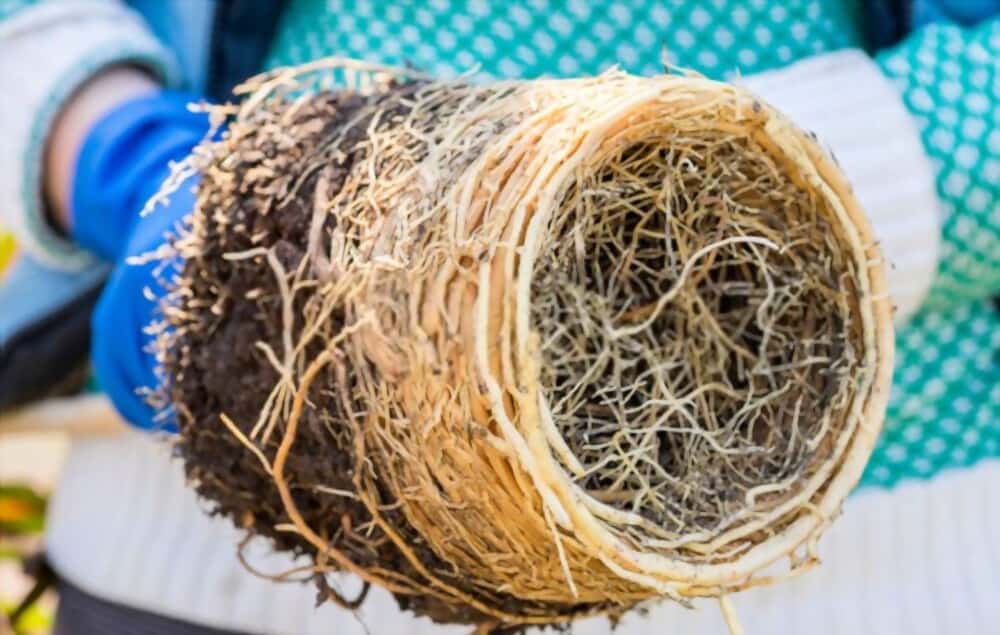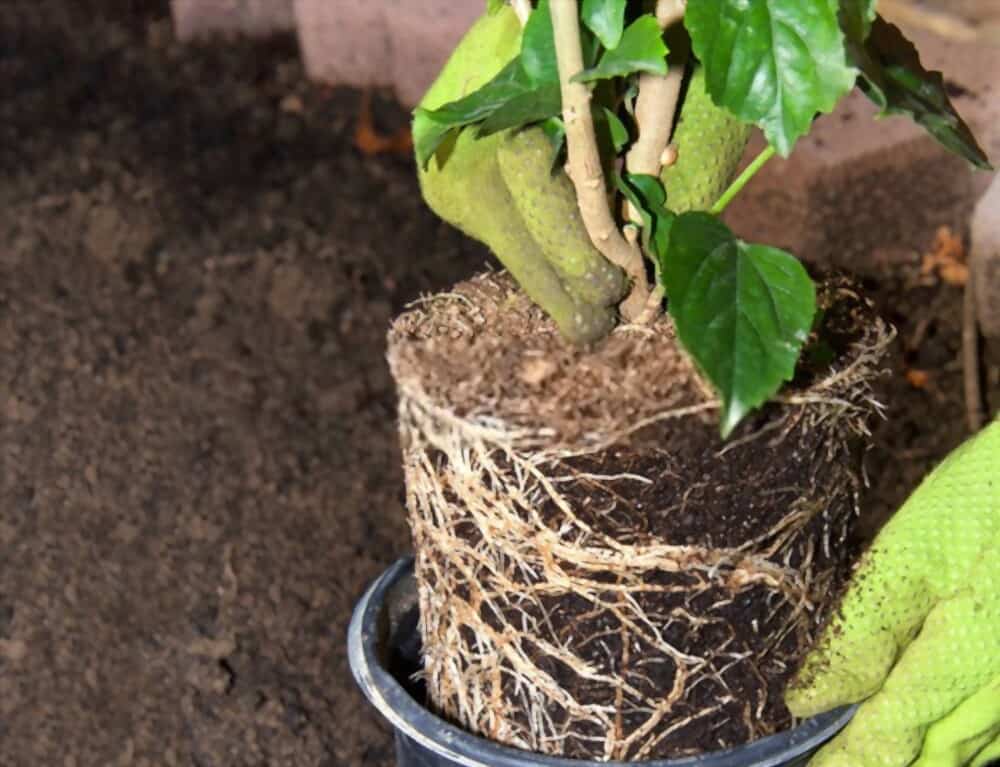
Plants in pots are frequently referred to as root-bound plants. Because of the space shortage caused by the roots’ clogging and overgrowth, these plants need to be repotted.
Others replace the soil in the pot with their coiled roots, while root-bound plants have a root ball that takes on the shape of the container. When a plant is root bound, it cannot get enough water, air, or nutrients, which can lead to a variety of issues.
A root-bound plant clusters its roots into a tight tangle as opposed to other plants, which have root systems that spread out like tree limbs. In addition to withering, smaller or yellow leaves, and stunted growth, the high root-to-soil ratio also causes.
We will discuss how to safely remove and repot a root-bound plant as well as what to anticipate when a plant is in this state because being root-bound is not always a good situation for a plant.
When repotting, add a touch of modernity to your house with this selection of lovely planters from Amazon that are reasonably priced.
Table of Contents
What does the Term Root Bound Mean
The phrase “root bound” has several different meanings.
The most widely accepted definition, however, states that a root-bound plant is one whose condition results in its roots being crowded, knotted, and dense due to a lack of room for additional growth.
When a plant has significant root binding, it is frequently necessary to shatter the container in order to remove it.
My plants stay healthy even after repotting thanks to the Miracle-Gro Potting Mix I get from Amazon. Clicking here will take you there.
What Plants Like to be Root Bound

Some plants prefer to be root bound, despite the fact that the majority of root-bound plants experience a variety of issues.
I’ll discuss these plants and explain why they enjoy being root-bound in this section. Read on!
A Peace Lily
If a peace lily is root-bound, it will produce lovely, healthy blossoms.
If you wish to transfer it to a bigger pot, make sure the new pot’s diameter is no greater than 10 mm from the old one.
If there is more soil in the container, a peace lily will develop the root rot issue.
Spider Plant
Spider plants grow and flourish at their best when they are root-bound, just as peace lilies.
Spider plants, on the other hand, typically develop more quickly, therefore you must repot them before they break their pots.
If the roots are not visible above the soil, wait to remove the plant. Despite being pot-bound, these plants eventually need to be replanted.
Snake Plant
Snake plants prefer to be root-bound, so you won’t have to repot them into bigger containers too often.
You should repot your snake plant into a larger pot if the roots start to poke through the drainage holes in the current container.
Jade Plant
Typically, a jade plant prefers to be root-bound in a tiny pot.
These plants will get smaller and easier to maintain if you keep them root-bound.
To promote healthy growth, you must, however, repot your jade plants at least once every two to three years.
After repotting, the plant must be without water for at least a week.
Hoya
Another plant that enjoys being root-bound is the hoya.
You must wait to repot these plants until you see the roots tangle or wrap around the interior of the container since they grow as epiphytes and enjoy damp conditions.
Likewise, repot your Hoya plant if it requires extra water.
Aloe Vera
Because it like to be root-bound, aloe vera makes a fantastic indoor plant.
Even if your aloe vera plants grow too large for their pot, transplanting them is not a pressing matter.
However, you need repot it after some time if it becomes root bound.
Boston Ferns
Given their stature, Boston ferns do not like to grow in huge containers.
However, when their roots mature and expand, these plants end up being pot-bound.
Boston ferns typically do not transplant well. It implies that you will harm the plant if you transplant a Boston fern that is root-bound.
After transplantation, the plant may occasionally die as a result.
Philodendron
Pothos and philodendron also enjoy having their roots tightly entangled in their containers.
For these plants to avoid the issue of root rot, they require soil that drains well.
Pothos or philodendron should be given potting soil, and the containers shouldn’t have any additional room.
You can prevent root rot that way.
Succulents
Because they don’t require repotting, succulents are wonderful indoor plants.
It is essential not to move or repot these plants due to their shallow root systems.
However, you should repot them as soon as you notice the roots poking through the container.
Before watering these plants, take sure to let the soil dry out.
The goal is to stop root rot and other issues.
Plants that Don’t Like to be Root Bound
Plants that are too big for their containers frequently topple over.Additionally, the soil in a small pot can dry up rapidly, necessitating frequent watering.
Root entanglement might cause your plant to experience issues including yellow leaves, stunted development, and no blossoms.
Monstera Deliciosa
Some plants require repotting in order to survive since they do not enjoy having their roots restricted.
Monstera deliciosa is one such plant that dislikes being root-bound as an example.
This plant can’t be grown in a small container because there won’t be enough nutrients, water, or oxygen.
Make careful to relocate your monstera deliciosa to a bigger container every two years if you have any.
Your plant will survive if its roots have enough room to spread out in this manner.
Your monstera deliciosa will also develop wholesome foliage at the same time.
Zanzibar Gem
Root boundness is not preferred by Zanzibar Gem plants.
These plants develop broad underground rhizomes that require more room within the planter.
Ensure that you repot the plant every two to three years into a pot that is one size larger than the prior one.
Laceleaf
Bright lighting, moist air, and well-drained soil are necessary for laceleaf plants.
Although these plants prefer not to be moved much, they can get root-bound and cause damage if that happens.
The plant should therefore be replanted in a little larger container than the one it was in before.
Weeping Fig
Another plant that dislikes being root-bound is the weeping fig.
These plants are temperamental and cannot handle stress, so if they become root-bound, they will drop their leaves and go through other undesirable changes.
In order to prevent issues, it is advisable to repot your weeping fig before it becomes root-bound.
Maranta Leuconeura
Beautiful indoor plants like the maranta need a broad, shallow container with drainage holes on the bottom.
Maranta is particularly vulnerable to root rot because of its fine and shallow roots.
Therefore, you ought to repot it before it develops root binding. Without a doubt, Maranta Leuconeura dislikes being rooted to the ground.
Summary of Plants that Like and Don’t like Being Root Bound
| Potentially Left Root Bound | not possible to left root bound |
|---|---|
| Calm Lily | The delicious monstera |
| Insect Plant | Gem of Zanzibar |
| Viper Plant | Laceleaf |
| Plant of Jade | Fig Weeping |
| Hoya | Leuconeura Maranta |
| ‘Ole Vera’ | |
| Bermuda Ferns | |
| Philodendron | |
| Succulents |
How Long Should You Leave a Plant Before Repotting?
As your house plant grows, you must transfer it to a larger pot.
The plant will become root- or pot-bound if there is not enough room for its roots.
The plant’s roots will thus constrict and form a tightly packed cluster, hindering healthy growth.
Repotting is typically necessary for plants every 12 to 18 months, depending on how actively they are growing.
Some plants grow slowly, so you can keep them in the same container for a long time.
However, it’s crucial to remember to regularly refill the soil.
For healthy growth, experts advise repotting your plants in the early spring.When it comes to watering your plant, you should wait at least 7 to 10 days. The goal is to repair any root damage that occurred during repotting.
While it heals, keep your plant in a cool, shaded area.
How to Remove a Root-bound Plant from the Pot?
Make sure to repot your plant at the appropriate period if you want to keep it robust and healthy.
Don’t wait too long because the root system may clog up and get crowded, leading to numerous damages.
The roots poking through the bottom drainage holes are the most typical indication of a root-bound plant.
I’ll explain how to free a root-bound plant from its container in this part. Continue to read!
Step 1:
The optimal time to take your root-bound plant out of the container is in the spring.
The plant usually grows more quickly and with greater vigor in the spring.
You ought to wait till the spring because of this.
If you move the plant in the fall or winter, it will take a long time for it to adjust to the new container.
Step 2:
Before removing the root-bound plant, water the pot.
Give the soil enough water so that it can absorb enough moisture to become wet.
Make sure the bottom drainage holes are used to expel any extra moisture.
Watering the pot will soften the soil and plant’s root ball, making it easier to remove.
Step 3:
Avoid grabbing your houseplant by the pot and yanking it out.
This will harm the stems and leaves of the plant. Careful planning and preparation are necessary for the removal process.
At the soil line, wrap your hand around the plant’s base.
Now flip the container upside down with your other hand.
The plant will naturally be pulled out of its container by gravity.
Tap the pot on a nursery table or any other hard surface if the plant does not come out readily.
How to Re-Pot a Root-Bound Plant
The necessity for repotting is indicated by a number of symptoms and indicators.
Repotting the plant is necessary, for instance, if the roots extend through the drainage holes in the planter.
You can watch for more signals, such as your plant’s roots pushing up and out of the container.
Slower growth is another indicator that the plant has become root-bound.
You should repot your plant if it is top heavy, topples over easily, or dries out more quickly than usual.
Your plant needs to be replanted if salt and minerals have accumulated in the container.
The sole remedy for a root-bound plant is repotting.
Here are the steps to pot or repot a root bound plant.
Step 1: Remove Your Plant from the Existing Container
The removal procedure was described above.
Make sure to tilt the plant sideways if you want to precisely remove it from its existing pot.
To remove the plant, tap the upside-down container against a hard surface while holding it gently by the leaves or stems.
Step 2: Loosen the Plant’s root with your Hands
The second step is to free the roots of your plant. To dislodge the roots, use mild pressure with your palms.
You can cut off the longer roots if necessary. Keep in mind not to cut the thicker roots at the base of the leaves.
To get the greatest cut, untangle your plant’s root-bound roots.
Step 3: Remove the Old Potting Mix
Either all or a third of the old potting soil can be removed.
The cause is that as your plant grew, it withdrew nutrients from the potting soil.
To give your plant more nutrients and minerals, you must remove the old mixture and replace it.
Step 4: Add Fresh Potting Mix
You need a new planter or container for repotting. The new container should be filled with brand-new potting soil or mix.
Make sure the air pockets are gone. The new container needs to have drainage holes at the bottom.
Before adding the fresh soil, you can overlay the ground with gravel, rocks, or lava rocks if there are no holes.
Step 5: Add your Root-Bound Plant
Insert your plant into the brand-new pot with the new soil mixture.
Ensure that the plant is positioned in the middle of the container.
To keep the plant upright after you’ve planted it, add more potting soil to the container.
The root won’t be able to breathe in new oxygen if there is too much soil in the container.
Before watering the soil in the new container, wait at least seven to 10 days.
By doing so, you allow the plant ample time to repair any harm it may have caused during the removal procedure.
Learn here how to create the best potting mix using soil amendments.
Will the Plant grow Bigger in a Bigger pot?
In a larger pot, the plant will often grow larger since the roots will have more room to spread out and absorb more nutrients, both of which will encourage growth.
Repotting will provide the plant extra nutrients and aeration from new soil in a larger pot. Additionally, because of the wider spacing, the roots will extend out in search of sustenance.
Will being Root Bound Prevent Further Plant Growth?
Despite the fact that some plants enjoy being root-bound, many of them would experience negative alterations.
For instance, root-bound plants will wilt fast, develop brown or yellow leaves, and grow slowly.
Wilting impairs the plant’s capacity to evolve and expand.
Reduced transpiration finally results in mortality for the organism.
A plant that is extremely root-bound finds it more difficult to stay in the container and the roots eventually push through the drainage holes.
Additionally, a root-bound state is bad for your plant because it won’t anchor, which lowers the likelihood of healthy development and transpiration.
As the roots of your plant fill the pot, there is less room for the soil to hold water, which causes the roots to die.
In addition to preventing the plant from acquiring enough nutrients, root bound will impede the plant’s growth and ultimately result in death.
As a result, the root-bound plant needs to be taken out of its current container and put in a pot that is somewhat larger.
Should you Encourage Plants to Become Root-bound
Some plants like to be root-bound, as was previously indicated.
However, excessive root binding can seriously injure the majority of plants.
Roots that are overgrown or tightly packed won’t receive enough water or nourishment.
It is wise to avoid having your plant get root-bound as a result.
Because the roots refill the potting soil, a plant that is root-bound is frequently sickly.
The plant may experience substantial stress as a result of the tightly entwined roots, which may prevent the roots, leaves, and stems from getting enough oxygen, water, and nutrients.
In order to expand the roots and allow for optimal growth and development, you must remove the root-bound plant and repot it in a larger container.
Will Excess Watering Cause Root Rot
The main cause of root suffocation is too much water. The roots of your plant may decay quickly as a result.
The roots will be harmed by too much water, and the leaves will turn yellow or brown, drop, and become soggy at the base.
Remember that overwatering can happen naturally and gradually, so if you give your plants too much water at once, root rot won’t result.
But if you keep watering your plant excessively, the plant will suffer.
For instance, if you have cacti or succulents, be sure to completely dry the soil before adding water.
Before watering, the top half of the soil must be completely dry for the majority of tropical indoor plants.
Make sure to dry the top of the soil if you have ferns or any other plants that require moisture before adding more water.
Simply misting the plant is an alternative to traditional watering. This avoids overwatering and the accompanying fungi infections.
– Spider plant.In a container, a plant that is extremely root-bound finds it more difficult to grow and the roots eventually push through the drainage holes.

Should the Roots Be Pruned?
Furthermore, your plant will suffer from a root-bound situation because it won’t anchor to its surroundings, which will decrease the likelihood of healthy growth and transpiration.
Because there is less area for the soil to hold water as the roots of your plant encroach on the interior of the pot, they will eventually die.
The plant won’t be able to obtain adequate nutrients, and root binding will also restrict its growth and ultimately result in death.
This means that the root-bound plant needs to be taken out of its current container and put in a somewhat larger one.
Some plants, as was previously indicated, like to be root-bound.
The majority of plants can suffer serious injury from excessive root binding, though.
Can a Plant Die from being Root Bound?
The roots won’t receive enough water or nutrients if they are overgrown or tightly packed.
In order to avoid your plant becoming root-bound, it is wise to do so.
The potting soil is often replaced by the roots of a root-bound plant, making it unhealthy.
The plant may experience substantial stress as a result of the tangled roots, which prevent the roots, leaves, and stems from getting enough oxygen, water, and nutrients.
Can a Root Bound Plant Recover?
To expand the roots for healthy growth and development, you must thus remove the root-bound plant and repot it in a larger container.
The main factor for root suffocation is an abundance of water. Your plant’s roots may swiftly decay as a result.
In addition to damaging the roots, too much water will also cause the leaves to become yellow or brown, drop, and saturate the base of the stems.
